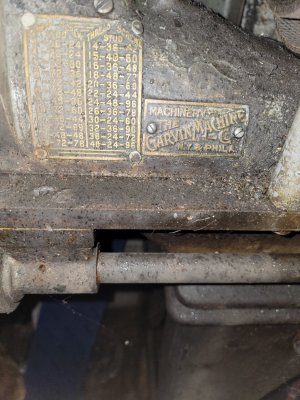Hi PAturner
Nov. 6 2023 Excel workbook file name: TPI_ManyLathesRev1 NB06_0054.xlsm
Here is an excel workbook that I wrote some time ago, which can be configured for almost any lathe. There are several lathes shown as the individual sheets which I have already set up. I have a PM1440 so I wrote if for that lathe. Later I duplicated this sheet and then modified it for several other lathe models. You can use any of these to customize to your lathe. The TPI of the lead screw is located at spread sheet cell H24, which can be changed to any value, i.e. 9. Likewise you can change the set of possible external gear teeth values. There is a macro available which will generate a table of all of the possible tpi values or the metric pitch values. One of the sheets contains a read me that will explain how to use it. If you do not feel you want to open my workbook with the macros active then just deactivate them. You can still use the spread sheets manually via a set of pull down tabs to select the gear configuration. See cell O30 and others to its right. After selecting a gear set with the pull down tabs the TPI value shows up at cell E24 or F24. The Metric values are at W24 and X24. The transpose gear values are located below the cell where "Gear shaft A" is the header , T28. Just put one of the transpose gear set values in both columns below A-A and A2Spin titles. You will see on my PM1440 the values of 127 and 120. By putting them in both columns you can generate gear ratio multipliers of 120/127, 127/120, as well as 120/120=127/127=1.
The macro which will generate the table for you is called. GenAllTPI. It generates a separate sheet table tab called "AllTPI" that contains all possible TPI values for the gear set you input below the pull down menus. When the macro runs it provides an option to eliminate duplicates. I suggest you choose not to eliminate the duplicates as I recently found a flaw in this code which leaves some gears set values out. (to be corrected one of theses days). If you choose NOT to eliminate duplicates then you get a complete table. Depending up on how many gears you lists in the possible gear set tables it can generate a very long table and the calculation time can become long. At the lower left corner of the spread sheet is a continual notification of the progress.
If you have difficulty understanding workbook or the Readme tab/sheet and want assistance just let me know. If I understand your lathe then I set up the gears and could run the table for you. If you have no gear box this becomes very straight forward. The Readme also tells you about other macros that can be used to sort or search the AllTPI table.
By the way, 127 is a special number of teeth. If you double it you get 254. There are 25.4 mm per inch and so many of the metric threads can be generated exactly on a lead screw even though it is in Imperial units. The 120 tooth gear is an easy multiple of 20, 40, 60 so at least one these values are common on one of the gear axles. Another transpose gear set, that is not bad, and is used on a number of lathes is the transpose gear set of 91/86 . Some lathes will have a TPI plate shown where exact metric pitch values are listed, but in reality the value obtained via the gears only approximates the standard mm pitch. They just gloss over this. The errors are usually quite small. Likewise, the feed, and especially, the x-feed plate values listed are not always accurate.
I believe that if you have a 9TPI lead screw then one of your gears will be a multiples or sub-multiples of 9, like: 15, 30, 45, 18, 27, 36 etc and this will tend to remove the effect of the lead screw tpi value. You may note that if all of the external gears yield a ratio of 1, then the TPI value generates is the same as the lead screw tpi value.
Dave L.




